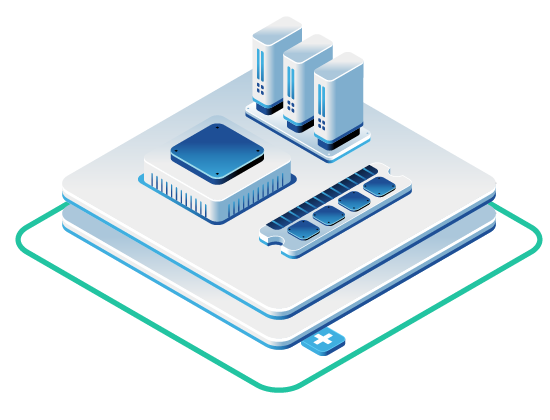In this article
- Understanding Proxmox VE + OpenMetal Bare Metal
- The Business Case: Why Choose This Combination
- Choosing the Right OpenMetal Hardware for Proxmox VE
- Real-World Use Cases
- Integration with OpenMetal’s Platform
- Getting Started: Deployment Path
- Market Context: The Bare Metal Resurgence
- Support and Resources
- Wrapping Up: Proxmox + Bare Metal
Organizations that want to control virtualization costs are deploying Proxmox Virtual Environment (Proxmox VE) on dedicated bare metal servers. When paired with OpenMetal’s infrastructure, this combination delivers enterprise-grade virtualization without licensing fees or unpredictable cloud bills.
Understanding Proxmox VE + OpenMetal Bare Metal
What Is Proxmox Virtual Environment?
Proxmox VE is an open source server virtualization platform that combines KVM (Kernel-based Virtual Machine) virtualization for full virtual machines and LXC for lightweight containers into a single management interface. Based on Debian GNU/Linux, Proxmox VE runs under the GNU AGPLv3 license, making it free to use without licensing costs.
The platform includes:
- Dual Virtualization Technologies: Run both full VMs (KVM) and lightweight containers (LXC) from one platform
- Web-Based Management: Control your entire virtualization environment through a browser interface
- High Availability Clustering: Build multi-node clusters with automatic failover
- Live Migration: Move running VMs between hosts with zero downtime
- Storage Management: Support for ZFS, Ceph, NFS, iSCSI, and more
- Software-Defined Networking: Configure VLANs, VXLANs, bridging, and SDN features
- Backup and Restore: Built-in backup tools with scheduling and retention policies
- Role-Based Access Control: Granular permissions for multi-tenant environments
“As of November 2025, the mindshare of Proxmox VE in the Server Virtualization Software category stands at 15.5%” (PeerSpot), with users praising its open source nature, HA capabilities, and cost-effectiveness.
Why OpenMetal Bare Metal Servers?
OpenMetal provides dedicated bare metal servers designed for demanding workloads like virtualization. OpenMetal servers include:
- Dual 10 Gbps Network Interfaces: 20 Gbps total bandwidth
- NVMe Storage: Micron 7450 or 7500 MAX series drives
- IPMI Remote Management: Full hardware-level control including power management, BIOS access, and console access
- Fixed Pricing: No per-VM licensing fees or surprise usage charges
- DDoS Protection: Built-in protection up to 10 Gbps per IP address
- Rapid Deployment: Instant provisioning from on-hand inventory
- Multiple Data Center Locations: Tier III facilities in the US, Netherlands, and Singapore
The Business Case: Why Choose This Combination
1. Eliminate Virtualization Licensing Costs
VMware’s licensing costs have increased dramatically following Broadcom’s 2023 acquisition. Effective April 10, 2025, VMware stopped selling perpetual licenses, moving entirely to subscription-only licensing with a mandatory 72-core minimum per order. Organizations face reported cost increases ranging from 150% to over 1,000%.
Proxmox VE eliminates these costs entirely. The base platform is free and open source, with no per-socket licensing fees, no per-VM charges, and no feature-gating behind expensive editions. You’ll only pay an additional cost if you choose to use a Proxmox Subscription that provides access to updates and security enhancements, along with enterprise-grade technical support.
2. Achieve Predictable Economics
Public cloud providers offer convenience but at significant cost. Research from Andreessen Horowitz found that “if you’re operating at scale, the cost of [public] cloud can at least double your infrastructure bill.”
OpenMetal’s pricing model differs from public cloud:
Fixed Monthly Pricing: Pay for dedicated hardware capacity, not individual VMs or usage metrics.
No Per-VM Charges: Create unlimited virtual machines within your hardware capacity.
Predictable Egress Costs: Generous included public bandwidth with 95th percentile pricing for overages:
- Small servers: 400 Mbps included bandwidth per server
- Medium servers: 1 Gbps included per server
- Large servers: 2 Gbps included per server
- XL servers: 4 Gbps included per server
- XXL servers: 4 Gbps included per server
- For clusters, egress allowances aggregate (e.g., three XL servers = 12 Gbps total included)
- Additional egress: $375 per Gbps monthly (approximately 180TB at 95th percentile measurement)
Many clients moving from public cloud have seen cloud spend decrease by as much as 50%, particularly when monthly spending exceeds $20,000.
3. Gain Performance Without Resource Contention
When running Proxmox VE on dedicated bare metal, every CPU cycle, every byte of RAM, and every IOPS belongs exclusively to your workloads. There’s no “noisy neighbor” problem and no artificial throttling.
A 2022 performance comparison conducted by Blockbridge found that Proxmox VE beat VMware ESXi in 56 of 57 tests, delivering IOPS performance gains of nearly 50%. Peak gains with large queue depths and small I/O sizes exceeded 70%. Proxmox VE reduced latency by more than 30% while delivering higher IOPS.
Performance advantages include:
- Full Hardware Access: Direct access to Intel Xeon Gold and Silver processors
- Consistent Performance: No competition from other tenants
- NVMe Storage Speed: Micron 7450 and 7500 MAX series NVMe drives deliver sequential reads of ~3.2 GB/s and writes of ~3.0 GB/s, with random IOPS approaching 700k
- Low-Latency Networking: Intra-host VM networking achieves ~18 Gbps throughput with sub-millisecond latency
- Hardware Passthrough: Pass GPUs, NICs, or other PCIe devices directly to VMs
4. Simplify Management Without Sacrificing Features
Proxmox VE 9.0, released in 2025, is built on Debian 13 “Trixie” with Linux Kernel 6.14. The platform delivers sophisticated capabilities through an interface that doesn’t require specialized expertise:
- Unified Web Interface: Manage all aspects from one dashboard
- RESTful API: Automate infrastructure provisioning through documented APIs
- Command-Line Interface: Full CLI access with intelligent tab completion
- Mobile Access: Manage VMs and access consoles from mobile devices
- No Separate Management Server: Multi-master architecture allows management from any cluster node
OpenMetal Central provides unified management for both bare metal infrastructure and Proxmox virtualization.
5. Build Complex Network Topologies
OpenMetal’s network architecture provides the foundation for sophisticated Proxmox networking:
- Dedicated VLANs: Your servers live on VLANs specific to your environment
- Pre-Configured VXLANs: VLANs configured to support overlay networking
- Public and Private Networks: Separate management, compute, and provider VLANs
- Bring Your Own IPs: Announce your own /24 or larger IP blocks
- Direct Internet Connection: Connect VMs directly to public internet
This configuration enables:
- NAT-based private VM networks with internet access
- VMs with dedicated public IP addresses
- Multi-tier application architectures with network isolation
- Software-defined networking with VXLAN tunneling
- BGP-based EVPN infrastructures for multi-site deployments
The OpenMetal Proxmox installation guide demonstrates these networking patterns.
6. Implement High Availability Without Third-Party Tools
Proxmox VE’s integrated HA features provide enterprise-grade reliability:
- Automatic Failover: HA Manager monitors all VMs and containers, automatically restarting them on healthy nodes
- Watchdog-Based Fencing: Simplified deployment with reliable fencing mechanisms
- Live Migration: Move running VMs between cluster nodes with zero downtime
- Cluster File System (pmxcfs): Database-driven file system that synchronizes configuration across all nodes
- Zero-Configuration HA: HA clustering works out-of-the-box
- HA Simulator: Test and learn HA behavior before production deployment
Combined with OpenMetal’s network performance, Proxmox clusters benefit from a stable foundation.
7. Access Flexible Storage Options
Proxmox VE supports virtually any storage technology in the Linux ecosystem:
- Local NVMe Storage: Micron 7450/7500 MAX series drives
- ZFS Support: Advanced filesystem with compression, deduplication, and snapshots
- Ceph Integration: Distributed storage across multiple nodes
- Network Storage: NFS, SMB/CIFS, iSCSI, GlusterFS support
- Multiple Storage Pools: Configure different storage backends for different workloads
- Thin Provisioning: Efficiently allocate storage without over-provisioning
- Live Storage Migration: Move VM disks between storage backends without downtime
OpenMetal servers can be configured with up to 6 NVMe drives (6.4TB each on Medium servers and above), providing massive local storage capacity.
8. Scale Cost-Effectively
As infrastructure needs grow, both Proxmox and OpenMetal scale without exponential cost increases typical of public cloud:
- Horizontal Scaling: Add cluster nodes as needed
- Vertical Scaling: Upgrade to larger server configurations
- No Per-VM Multiplication: Costs remain predictable regardless of VM count
- Storage Scaling: Add storage capacity by deploying additional NVMe drives
- Network Scaling: Use OpenMetal’s 20 Gbps per-server bandwidth and aggregate allowances
- Scheduled Deployments: Work with account managers to coordinate hardware delivery
OpenMetal keeps common hardware in stock and can typically deploy up to 12 servers of a particular type instantly, with larger deployments coordinated through our supply chain.
9. Maintain Open-Source Foundation
Proxmox VE’s open source nature under GNU AGPLv3 provides:
- No Vendor Lock-In: Full access to source code and freedom to modify
- Security Through Transparency: Audit code for security vulnerabilities
- Active Community: Documentation, forums, and community support
- Ecosystem Integration: Works with other open source tools including Kubernetes, Ansible, Terraform
- Export Freedom: Standard formats (qcow2, raw) ensure VM portability
10. Get Backup and Disaster Recovery Included
Proxmox VE includes backup and restore capabilities at no additional cost:
- Integrated Backup Tool (vzdump): Creates consistent snapshots of running VMs and containers
- Scheduled Backups: Automated backup jobs with retention policies
- Multiple Backup Targets: Local storage, NFS, SMB/CIFS, or Proxmox Backup Server
- Incremental Backups: When using Proxmox Backup Server, only changed data transfers
- Live-Restore: Start VMs immediately while backup restoration continues
- File-Level Restore: Extract individual files from backups without full VM restoration
- Compressed and Encrypted Backups: Reduce storage requirements and protect data
OpenMetal’s high-speed network (dual 10 Gbps) facilitates rapid backup transfers to remote locations.
Choosing the Right OpenMetal Hardware for Proxmox VE
The right server configuration depends on workload requirements, VM density, and performance expectations.
For Development, Testing, and Small Production: Medium V4
Hardware Specifications:
- CPUs: Dual Intel Xeon Silver 4510 (24 cores/48 threads total, 2.4/4.1GHz)
- RAM: 256 GB DDR5 4400MHz
- Storage: 1x 6.4TB NVMe (up to 6 slots available) + 2x 960GB boot disks
- Network: Dual 10 Gbps NICs (20 Gbps total)
Best For:
- Development and testing environments
- Learning Proxmox capabilities
- Small production workloads (10-30 VMs)
- Department-level virtualization
- Proof-of-concept deployments
The Medium V4 offers balanced resources at an accessible price point. The 256 GB of RAM supports reasonable VM density while the dual Xeon Silver processors provide solid performance for non-critical workloads.
For Production Workloads: Large V4
Hardware Specifications:
- CPUs: Dual Intel Xeon Gold 6526Y (32 cores/64 threads total, 2.8/3.9GHz)
- RAM: 512 GB DDR5 5200MHz
- Storage: 2x 6.4TB Micron 7450 or 7500 MAX NVMe + 2x 960GB boot disks
- Network: Dual 10 Gbps NICs (20 Gbps total)
Best For:
- Production application hosting (30-70 VMs)
- Database servers requiring consistent performance
- Multi-tier application environments
- Medium-scale web hosting
- Development platforms serving multiple teams
- Moderate Kubernetes clusters
The Large V4 represents the sweet spot for many production deployments. The Xeon Gold 6526Y processors deliver strong single-threaded and multi-threaded performance, while 512 GB of RAM supports higher VM density.
For High-Density Virtualization: XL V4
Hardware Specifications:
- CPUs: Dual Intel Xeon Gold 6530 (64 cores/128 threads total, 2.1/4.0GHz)
- RAM: 1 TB DDR5 4800MHz
- Storage: 4x 6.4TB Micron 7450 or 7500 MAX NVMe + 2x 960GB boot disks
- Network: Dual 10 Gbps NICs (20 Gbps total)
Best For:
- High-density VM environments (70-150 VMs)
- Memory-intensive applications (SAP, Oracle, large databases)
- Medium to large Kubernetes clusters
- Analytics platforms and data warehouses
- Virtual desktop infrastructure (VDI)
- Multi-tenant environments
The XL V4 increases both compute and memory capacity. With 64 cores and 1 TB of RAM, this configuration handles substantial VM densities while maintaining performance.
For Maximum Performance and Scale: XXL V4
Hardware Specifications:
- CPUs: Dual Intel Xeon Gold 6530 (64 cores/128 threads total, 2.1/4.0GHz)
- RAM: 2 TB DDR5 4800MHz
- Storage: 6x 6.4TB Micron 7450 or 7500 MAX NVMe + 2x 960GB boot disks
- Network: Dual 10 Gbps NICs (20 Gbps total)
Suitable For:
- Maximum VM density (150-300+ VMs)
- Large-scale database consolidation
- AI/ML training and inference workloads
- Big data analytics (ClickHouse, Hadoop, Spark)
- High-throughput data processing
- Large Kubernetes production clusters
The XXL V4 represents OpenMetal’s flagship virtualization platform. With 2 TB of RAM and 64 cores, this server can host hundreds of VMs or provide massive resources to resource-intensive applications.
Real-World Use Cases
Use Case 1: Migrating from VMware to Escape Licensing Costs
Scenario: A mid-sized organization running 200 VMs on VMware vSphere faces renewal costs exceeding $150,000 annually for licensing and support. They need HA, live migration, and distributed resource scheduling.
Solution: Deploy three OpenMetal XL V4 servers with Proxmox VE in an HA cluster.
Results:
- Eliminate $150,000+ in annual VMware licensing
- Maintain all required enterprise features
- Gain newer hardware with faster NVMe storage
- Achieve 60%+ infrastructure cost reduction
Use Case 2: Public Cloud Repatriation
Scenario: A SaaS company running 80 application servers on AWS spends $45,000 monthly ($540,000 annually) on EC2 instances, EBS storage, and data transfer.
Solution: Deploy two OpenMetal Large V4 servers running Proxmox VE to host application tier, retain AWS for true on-demand workloads.
Results:
- Reduce infrastructure spend to approximately $1,800 monthly for Proxmox hosts ($21,600 annually)
- Savings of $518,400 annually (96% reduction on migrated workloads)
- Eliminate surprise egress charges
- Improve application performance on dedicated hardware
This mirrors findings from OneUptime’s 2025 analysis, which reported over 76% savings comparing bare metal to AWS, with 730+ days of 99.993% measured availability.
Use Case 3: Development and Testing Infrastructure
Scenario: A software development company needs isolated environments for 15 development teams, each requiring 3-5 VMs per team member.
Solution: Deploy one OpenMetal Large V4 server with Proxmox VE, using resource pools and permissions for team isolation.
Results:
- Support for 75-100 development VMs on single server
- Teams can self-service provision VMs through web interface
- Rapid VM cloning from templates speeds developer onboarding
- Snapshot capability for safe experimentation
- Fixed monthly cost regardless of VM count
Use Case 4: Database Consolidation
Scenario: An enterprise running 40 database servers (PostgreSQL, MySQL, MongoDB) on aging hardware needs to modernize without migrating to DBaaS platforms.
Solution: Deploy two OpenMetal XL V4 servers in Proxmox HA cluster, with each database in its own VM.
Results:
- Consolidate 40 physical servers to 2 modern bare metal hosts
- Each database VM has dedicated CPU cores (pinning) for consistent performance
- NVMe storage delivers 10x IOPS improvement over spinning disks
- HA cluster provides automatic failover for databases
- Backup integrated into Proxmox with point-in-time recovery
Use Case 5: Multi-Tenant Hosting Platform
Scenario: A managed service provider needs to host customer applications in isolated environments with flexible resource allocation.
Solution: Deploy multiple OpenMetal servers (Large V4 and XL V4) running Proxmox VE with role-based access control.
Results:
- Separate permissions per customer using Proxmox authentication realms
- Customers manage their own VMs through delegated access
- Fixed infrastructure costs for predictable margins
- Live migration allows non-disruptive maintenance
- Per-customer resource pools ensure fair allocation
Integration with OpenMetal’s Platform
While Proxmox VE on standalone bare metal servers provides value, OpenMetal’s platform offers additional integration possibilities.
Hybrid Deployments: Bare Metal + Hosted Private Cloud
OpenMetal’s architecture allows bare metal Proxmox servers to integrate with OpenMetal’s Hosted Private Cloud (OpenStack-based) deployments:
- Shared VLANs: Bare metal Proxmox hosts and OpenStack cloud share the same private networks
- Unified Management: Manage both environments through OpenMetal Central
- Flexible Workload Placement: Choose between Proxmox VMs and OpenStack instances based on requirements
- Shared Storage: Bare metal servers can consume OpenStack Ceph block and object storage
- Consistent Networking: Single network topology spans both platforms
OpenMetal Central: Unified Infrastructure Management
OpenMetal Central serves as the management layer for all OpenMetal resources:
- Project-Based Organization: Group servers by application, department, or customer
- Budget Controls: Set spending limits per project
- API-Driven Provisioning: Automate server deployment through OpenMetal API
- IPMI Access: Manage power, console, and BIOS settings
- Network Configuration: Configure VLANs, IP assignments, and routing
- Multi-User Access: Role-based permissions for team collaboration
Getting Started: Deployment Path
Phase 1: Pilot Deployment (Week 1-2)
- Provision Initial Server: Deploy one OpenMetal Medium V4 or Large V4 server via OpenMetal Central
- Install Proxmox VE: Follow the OpenMetal Proxmox installation guide
- Configure Networking: Set up management, compute, and provider VLANs per requirements
- Create Test VMs: Deploy representative workloads to validate performance
- Establish Backup Procedures: Configure vzdump or Proxmox Backup Server integration
- Train Team: Familiarize staff with Proxmox web interface and CLI
Phase 2: Production Migration (Week 3-8)
- Deploy Production Cluster: Provision 3+ servers for HA capabilities
- Configure Proxmox Cluster: Join nodes into clustered configuration
- Set Up HA: Configure resource groups and failover policies
- Migrate Workloads: Use P2V tools or manual VM creation to migrate applications
- Implement Monitoring: Deploy monitoring tools (Prometheus, Grafana)
- Document Configuration: Record network topology, storage layout, and access controls
Phase 3: Optimization (Ongoing)
- Right-Size VMs: Adjust CPU and RAM allocations based on actual usage
- Tune Storage: Adjust filesystem parameters, implement caching strategies
- Refine Backup Policies: Adjust retention and scheduling based on requirements
- Automate Operations: Develop Ansible playbooks or scripts for common tasks
- Plan Capacity: Monitor resource utilization and schedule hardware additions
- Review Costs: Validate cost savings and adjust infrastructure as business evolves
Market Context: The Bare Metal Resurgence
The shift toward bare metal for stable workloads reflects broader industry trends. Organizations are moving workloads out of cloud due to high costs, with certain workloads reducing total cost of ownership (TCO) by as much as 40% when repatriated to dedicated infrastructure.
The global bare metal market is expected to reach $56.6 billion by 2031, driven by demand for high-performance computing, AI workloads, and cost control.
Support and Resources
OpenMetal Support
- Cloud Support Services: Assistance with infrastructure and Proxmox deployment
- Account Managers: Dedicated contacts for planning deployments
- Technical Documentation: Guides in OpenMetal documentation portal
- Sales Consultation: Free consultations to assess requirements
- Contact: sales@openmetal.io
Proxmox Resources
- Official Documentation: Proxmox VE admin guide at pve.proxmox.com
- Community Forums: Active community for troubleshooting and best practices
- Wiki: Technical articles and tutorials
Wrapping Up: Proxmox + OpenMetal
 The combination of Proxmox VE and OpenMetal bare metal infrastructure delivers an alternative to expensive public cloud platforms and proprietary virtualization solutions. Organizations gain:
The combination of Proxmox VE and OpenMetal bare metal infrastructure delivers an alternative to expensive public cloud platforms and proprietary virtualization solutions. Organizations gain:
- Cost Savings: 50%+ reduction compared to public cloud, elimination of virtualization licensing fees
- Enterprise Features: HA clustering, live migration, sophisticated networking, all included
- Predictable Pricing: Fixed monthly costs without surprise usage charges
- Performance: Dedicated hardware with NVMe storage and 20 Gbps networking
- Simplicity: Management without licensing complexity
- Flexibility and Control: Open source foundation with complete hardware access
- Scalability: Grow from single servers to multi-datacenter clusters
Whether escaping VMware licensing costs, repatriating workloads from public cloud, consolidating aging infrastructure, or building new virtualization platforms, Proxmox VE on OpenMetal bare metal provides an enterprise-grade solution.
Our technical implementation guide shows that deployment is straightforward, and OpenMetal’s support team assists with planning and implementation.
Ready to explore how Proxmox VE on OpenMetal bare metal can transform your infrastructure? Request a free trial or schedule a consultation with OpenMetal’s team to design a solution tailored to your requirements.
Schedule a Consultation
Get a deeper assessment and discuss your unique requirements.
Read More on the OpenMetal Blog


































